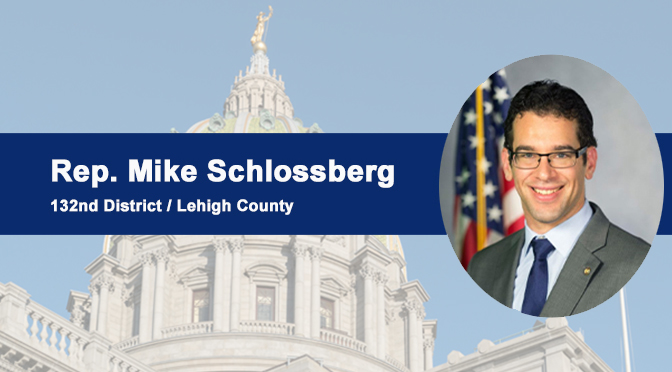HARRISBURG, Feb. 4 – State Rep. Mike Schlossberg offers the following statement in response to the proposed new legislative boundaries for the 132nd District in Lehigh County and the final proposal released by the Legislative Reapportionment Commission. A list of the voting precincts affected is available below the statement.
“I have several reactions to the effects on the 132nd District and Pennsylvania as a whole.
“For too long, using a process that was not transparent or fair, redistricting has been used as a tool to carve up communities and stack the deck for one political party or the other. The maps approved by the Legislative Reapportionment Commission this year, however, reflect transparency in the process and fairness in outcome. These maps would finally reverse decades of gerrymandering. Further, the maps would positively affect representation across Pennsylvania and in our community for the next decade, especially in communities where population growth has been driven by Hispanic populations. The maps are not perfect. Perfect is not attainable when it comes to redistricting. However, these maps are far better than anything produced in decades past. The Legislative Reapportionment Commission should be commended for the work it performed.
“Locally, Lehigh County has seen remarkable and sustained population growth. The legislative districts were going to shift to reflect that, especially since there were parts of the state which saw population decline.
“The growth in Lehigh County is great news for us all, and it is extremely beneficial to have a third state representative for the state’s third largest city. It is a statement to the growing population and political power of our region. It will also give more influence, access to state resources and opportunities to get things done to benefit the residents of our region. Specifically, I expect greater attention to be paid to the Allentown School District and the City of Allentown. When it comes to representation, two is fine: three is better.
“The new legislative districts will mean more Hispanic representation. This reflects our region’s diversity and the fastest growing demographic. When it comes to representation, legislative district lines should reflect the makeup of the population.
“For the 132nd District, the shifts are similar to the preliminary plan released by the Legislative Reapportionment Commission in December. The only changes would be the removal of two Allentown precincts originally included in the preliminary plan, and the addition of an Upper Macungie precinct. This appears to have been done in an attempt to reduce the number of municipalities split into different districts in other parts of Lehigh County.
“The inclusion of all South Whitehall Township and portions of Upper Macungie Township are a welcome change to the 132nd District. These are very important municipalities in our region, and they have shown remarkable growth. The struggles in these communities are familiar: education, health care, mental health, jobs that pay, responsible economic growth.
“Representing the East Side and portions of Center City Allentown has been a true honor. I am terribly sad to see the East Side and center city neighborhoods leave the 132nd District. The people who live in these communities are wonderful people. I do not get to choose the people I represent, but I do choose to consider them fondly and treasure the work we have done together.
“The services my office offers will continue to serve the current 132nd Legislative District until after the 2022 election. The geography of those services will change heading into 2023. However, the people living in the 132nd Legislative District — whether it will be your district in the future or not — can expect to be served through my office until after the 2022 election.”
New 132nd District (*signifies addition to existing district)
- Allentown 8-4 (Luis Ramos Elementary)
- Allentown 8-7 (Lehigh County Voting Machine Building)
- Allentown 11-4 (Muhlenberg College)
- Allentown 11-5 (Agricultural Hall)
- Allentown 11-6 (Calvary Moravian Church)
- Allentown 11-7 (Christ Evangelical Congregational Church)
- Allentown 13-4 (William Allen High School)
- Allentown 17 (1-4) (Agricultural Hall, First Presbyterian Church)
- Allentown 18 (1-2) (Union Terrace Elementary School, St. Timothy’s Evangelical Lutheran Church)
- South Whitehall 1 (Greenawalds Fire Co.)
- South Whitehall 2 (First Baptist Church)
- *South Whitehall 3 (Cetronia Fire Co.)
- *South Whitehall 4 (Cedar Crest College—Alumnae Hall)
- *South Whitehall 5 (Calvary Baptist Church)
- *South Whitehall 6 (Calvary Temple Church)
- South Whitehall 7 (Calvary Temple Church)
- *South Whitehall 8 (Jordan United Church of Christ)
- *Upper Macungie 1 (Trinity Wesleyan Church)
- *Upper Macungie 2 (Atas International Inc.)
- *Upper Macungie 4 (Clubhouse at Cold Water Crossing)
- *Upper Macungie 5 (Trinity Wesley Church)
- *Upper Macungie 6 (St. Paul’s Lutheran Church)
No longer in 132nd District
- Allentown 6-2 (Sheridan Elementary)
- Allentown 8-3 (St. Luke’s Lutheran Church)
- Allentown 8-5 (St. Francis Parish Center)
- Allentown 8-6 (Rivers of Life Seibert Church)
- Allentown 10-3 and 10-4 (Dubbs Memorial Community Center)
- Allentown 11-3 (Emmanuel United Church of Christ)
- Allentown 13-1 and Allentown 13-2 (Allentown Public Library)
- Allentown 13-3 (Lehigh Valley Active Life)
- Allentown 14-1 (Big Brothers/Big Sisters of the Lehigh Valley)
- Allentown 15 (East Side Youth Center, St. Peter’s Lutheran Church, Dieruff High School)
What’s Next?
-
- Per the Pennsylvania Constitution (Article II, Section 17), any aggrieved person may appeal the final plan directly to the state Supreme Court to rule on whether the final plan is contrary to law.
- If the plan is contrary to law, the Supreme Court would remand the plan to the Legislative Reapportionment Commission with a direction to adjust it.
- Very important: unlike Congressional redistricting, there is no vote taken by the General Assembly on the plan. The governor cannot veto the plan. The LRC plan can only be altered by the commission or the state Supreme Court.
Information provided to TVL by:
Tom Andrews
House Democratic Communications Office




